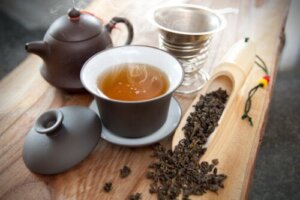Oolong Tea: Learn How to Prepare It and Enjoy Its Benefits


Reviewed and approved by the doctor Leonardo Biolatto
Oolong tea comes from the Camellia sinensis plant, the same as black and green tea. In fact, it’s one of the six main types of tea made from this species. It’s also known as “blue tea” and is a semi-fermented variety that stands out for its flavor, aroma, and nutritional qualities.
A review shared by Food Science and Human Wellness details that only 2% of all tea produced worldwide corresponds to this Chinese tea. And although its main consumers are in Taiwan, it’s gained popularity in countries such as the United States, Japan, and India. What benefits are attributed to it? Find out here!
How is oolong tea produced?
Oolong tea is one of the most popular traditional Chinese teas. Like green tea and black tea, it’s obtained from the leaves of the Camellia sinensis species; however, its main difference lies in the way it’s produced, which slightly changes its nutritional composition and organoleptic qualities.
To understand this, we must talk about the oxidation process. This is a chemical reaction that occurs when leaves are exposed to air. In the case of green tea, production is made from fresh leaves that have not undergone this process.
Meanwhile, black tea is a completely oxidized variety. The leaves are crushed and withered in the sun until they acquire their characteristic shade. Hence, it’s considered a fermented variety.
In the case of oolong tea, the airing and drying time is partial. In other words, it’s in between green tea and black tea.
Due to a moderate level of oxidation, its color and aroma differ. Meanwhile, the flavor can vary from floral to grassy and from sweet to roasted, depending on its degree of oxidation.
We think you may be interested in reading this, too: 10 Benefits of Black Tea According to Scientific Evidence
Nutritional composition of oolong tea
Oolong tea stands out for being an abundant source of antioxidant compounds.
As stated in a publication in the journal Molecules magazine, it concentrates polyphenols such as theaflavins, thearubigins, and epigallocatechin gallate (EGCG), which are linked to many of its positive health effects.
As for other nutrients, it provides calcium, magnesium, potassium, vitamin A, B vitamins, and vitamin C. However, these are very small amounts that are not very relevant when it comes to meeting the daily requirements.
Meanwhile, the United States Department of Agriculture (USDA) details that its caffeine content per 100 grams is 38 milligrams. This is higher than that of green tea, which provides 29 mg per 100 grams.
It’s estimated that a cup of oolong tea (prepared with about 2 grams of leaves per 250 milliliters of water) provides only 2.4 calories. It contains no protein, fat, sugar or fiber. Its carbohydrate intake is only 0.36 grams.

How is oolong tea prepared?
Due to its popularity in recent years, oolong tea is available in almost any health food store or herbalist’s store. It can be found pre-packaged in tea bags, or in loose leaves.
When preparing it, it’s recommended to use water that is at boiling point (about 90 degrees Celsius). When the water comes to a boil and the temperature is too high, the amount of antioxidants is reduced and the flavor may change.
A useful tip is to brew the tea in hot water and let it cool for 10 to 15 minutes for better concentration.
Ingredients
- 2 tablespoons of loose oolong tea leaves (2-3 grams). A tea bag can be used instead.
- 1 cup of water (250 milliliters).
How to make it
- Heat the water, without letting it reach a boil.
- After that, add the oolong tea in loose leaves or in a tea bag.
- Filter it for 3 minutes.
- Then, let it steep for another 10 minutes before drinking.
The potential health benefits of oolong tea
Much of the effects of oolong tea are associated with its antioxidant content. These substances have the ability to protect cells against free radicals, molecules associated with premature aging, and an increased risk of disease. Here are its main benefits.
1. It can reduce your risk of diabetes
The anti-diabetic potential of oolong tea is attributed to its polyphenol content. A review shared through the journal Antioxidants suggests that its consumption may protect against diabetes mellitus and its associated complications.
In particular, evidence suggests that it improves insulin resistance, activates the insulin signaling pathway, combats oxidative stress, and decreases the inflammatory response, which is key to the control of high glucose.
Research shared in the journal Molecules reported similar findings. According to the publication, catechins, theaflavins, and polysaccharides contained in this tea have beneficial effects on type 2 diabetes.
This is because they help mitigate oxidative stress, improve endo-lethal dysfunction, modulate cytokine expression, and improve insulin resistance. They also reduce complications associated with hyperglycemia and strengthen immune functions.
2. It supports weight loss
Included in the framework of a healthy and balanced diet, oolong tea can serve as a support to promote weight loss. These effects are not only linked to its antioxidant activity, but also to its ability to enhance enzyme inhibition and modulate the intestinal microbiota.
In a review reported in the journal Molecules researchers determined that the epigallocatechin gallate (EGCG) in oolong tea, as well as its polyphenol metabolites, have weight loss-promoting properties.
But more than its antioxidant effect and bioavailability, these qualities are associated with the modulation of the gut microbiota. The interaction between digested non-residual carbohydrates and tea polyphenols helps the generation of short-chain fatty acids (SCFA), which are key to maintaining a healthy gut.
Evidence associates weight loss with gut microbiota diversity and decreased intestinal permeability.
3. It helps care for cardiovascular health
The polyphenols contained in oolong tea are linked to several positive effects on cardiovascular health. They contribute to the breakdown of excess cholesterol and triglycerides, lipid substances that can cause thickening and clogging of the arteries (atherosclerosis).
In a population-based study shared by the British Journal of Nutrition, researchers linked prolonged consumption of oolong tea to a lower risk of dyslipidemia (elevated cholesterol, triglycerides, or both). Meanwhile, research shared by the Journal of Epidemiology and Community Health associated oolong tea intake with a 61% reduction in the risk of cardiovascular disease.
Other relevant effects are related to the reduction of high blood pressure and the risk of ischemic heart disease. A study in the journal Nutrients suggests that tea and its secondary metabolites have antihypertensive effects by aiding in smooth muscle relaxation, reduction of vascular inflammation, generation of nitric oxide, and inhibition of oxidative stress.
4. Oolong tea Contributes to cognitive health
Because of its content of L-theanine, caffeine, and antioxidants, oolong tea aids in cognitive health care. These substances act as brain stimulants and are associated with the prevention of age-related cognitive decline.
In research shared by Frontiers in Nutrition, researchers determined that the habit of consuming tea may help prevent memory loss and associative learning by affecting the volume of the posterior corpus callosum.
Another study reported by BMC Nutrition reported that higher tea consumption is associated with better performance on measures of focused and sustained attention and psychomotor speed tasks in the elderly.
Although more studies are lacking regarding these benefits, evidence points to oolong tea helping to improve mood, increase attention, and reduce the risk of Alzheimer’s disease and dementia.

Like this article? You may also like to read: 13 Herbal Teas to Prevent or Treat Menstrual Cramps
5. It has anti-tumor potential
Most of the studies on the anticancer effects of tea have been conducted with green tea and black tea. It’s possible that oolong tea, being in between the two, may have similar effects.
In particular, antioxidant compounds such as polyphenols have been found to help decrease cell mutations that can lead to the development of cancer. To be more precise, studies associate their consumption with decreased risk of lung, esophageal, liver, and colorectal cancers.
For now, more human studies are needed to evaluate these properties. Although the tea’s chemopreventive qualities are recognized, its consumption is preventive and merely complementary.
Other possible benefits of oolong tea
In general, teas derived from the species Camellia sinensis species-including oolong tea-are linked to other health benefits. Related studies are still ongoing; however, the evidence gathered so far has been sufficient to label it as a “functional food”.
- It aids in bone strengthening. A study shared in Osteoporosis International found that tea consumption helps reduce the risk of osteoporosis, especially in women and older adults. Catechins, theorubigins, and theaflavins were classified as osteoprotectants.
- It contributes to dental care. The fluoride found in oolong tea is associated with the prevention of dental cavities. In addition, it appears to help reduce the formation of dental plaque and gingivitis.
- It has skincare benefits. The abundant concentration of antioxidants in oolong tea helps inhibit the negative effects of free radicals, which in turn are associated with premature skin aging. It’s also considered beneficial in cases of eczema and sunburn.
Safety and risks of oolong tea
A moderate consumption of oolong tea is considered safe for most people.
However, it shouldn’t be ignored that it contains caffeine, so excessive intake isn’t recommended. This stimulant substance is linked to side effects, such as headache, insomnia, and heart rhythm disturbances.
Intake of up to 400 mg of caffeine is considered safe. It would take about 2 liters of oolong tea to exceed this amount. Thus, in general terms, it’s a safe food.
Cautious consumption is recommended in the following cases:
- Young children
- Pregnancy and lactation
- Kidney diseases
- Patients with arterial hypertension
- People with anxiety and depression
- Patients with diagnosed osteoporosis
In all these cases, it’s advisable to consult your doctor before taking this drink, especially if you are taking medication. As with other herbal products, there’s a risk of interactions.
We think you may also like to read this article: What Happens to Your Body if You Drink Green Tea Every Day?
What to remember about oolong tea
Oolong tea is a variety of semi-fermented tea that comes from the Camellia sinensis plant. It’s considered the intermediate between green tea and black tea, as it undergoes a partial oxidation process. Even so, they are similar in nutritional qualities.
Since it’s a source of polyphenols such as theaflavins, thearubigins, and epigallocatechin gallate (EGCG), its consumption is associated with cardioprotective, antitumor, antidiabetic, slimming, anti-inflammatory, and antioxidant effects.
In the context of a balanced diet and a healthy lifestyle, its consumption can contribute to the prevention of diseases and the maintenance of a healthy weight. A maximum of two to three cups a day is considered safe. So, would you like to try it?
All cited sources were thoroughly reviewed by our team to ensure their quality, reliability, currency, and validity. The bibliography of this article was considered reliable and of academic or scientific accuracy.
-
Aboulwafa, M. M., Youssef, F. S., Gad, H. A., Altyar, A. E., Al-Azizi, M. M., & Ashour, M. L. (2019). A Comprehensive Insight on the Health Benefits and Phytoconstituents of Camellia sinensis and Recent Approaches for Its Quality Control. Antioxidants (Basel, Switzerland), 8(10), 455. https://www.ncbi.nlm.nih.gov/pmc/articles/PMC6826564/
-
Daglia, M., Di Lorenzo, A., Nabavi, S. F., Sureda, A., Khanjani, S., Moghaddam, A. H., Braidy, N., & Nabavi, S. M. (2017). Improvement of Antioxidant Defences and Mood Status by Oral GABA Tea Administration in a Mouse Model of Post-Stroke Depression. Nutrients, 9(5), 446. https://www.ncbi.nlm.nih.gov/pmc/articles/PMC5452176/
- FoodData Central. (s. f.). https://fdc.nal.usda.gov/fdc-app.html#/food-details/1104264/nutrients
-
Fu, Q. Y., Li, Q. S., Lin, X. M., Qiao, R. Y., Yang, R., Li, X. M., Dong, Z. B., Xiang, L. P., Zheng, X. Q., Lu, J. L., Yuan, C. B., Ye, J. H., & Liang, Y. R. (2017). Antidiabetic Effects of Tea. Molecules (Basel, Switzerland), 22(5), 849. https://www.ncbi.nlm.nih.gov/pmc/articles/PMC6154530/
-
Guo, Z., Jiang, M., Luo, W., Zheng, P., Huang, H., & Sun, B. (2019). Association of Lung Cancer and Tea-Drinking Habits of Different Subgroup Populations: Meta-Analysis of Case-Control Studies and Cohort Studies. Iranian journal of public health, 48(9), 1566–1576. https://pubmed.ncbi.nlm.nih.gov/26412579/
-
Huang, Y. Q., Lu, X., Min, H., Wu, Q. Q., Shi, X. T., Bian, K. Q., & Zou, X. P. (2016). Green tea and liver cancer risk: A meta-analysis of prospective cohort studies in Asian populations. Nutrition (Burbank, Los Angeles County, Calif.), 32(1), 3–8. https://doi.org/10.1016/j.nut.2015.05.021
-
Klepacka, J., Tońska, E., Rafałowski, R., Czarnowska-Kujawska, M., & Opara, B. (2021). Tea as a Source of Biologically Active Compounds in the Human Diet. Molecules (Basel, Switzerland), 26(5), 1487. https://www.ncbi.nlm.nih.gov/pmc/articles/PMC7967157/
-
Koutoukidis, D. A., Jebb, S. A., Zimmerman, M., Otunla, A., Henry, J. A., Ferrey, A., Schofield, E., Kinton, J., Aveyard, P., & Marchesi, J. R. (2022). The association of weight loss with changes in the gut microbiota diversity, composition, and intestinal permeability: a systematic review and meta-analysis. Gut microbes, 14(1), 2020068. https://www.ncbi.nlm.nih.gov/pmc/articles/PMC8796717/
- Li, J., Romero-Garcia, R., Suckling, J., & Feng, L. (2019). Habitual tea drinking modulates brain efficiency: evidence from brain connectivity evaluation. Aging, 11(11), 3876-3890. https://pubmed.ncbi.nlm.nih.gov/31209186/
-
Liu, J., Liu, S., Zhou, H., Hanson, T., Yang, L., Chen, Z., & Zhou, M. (2016). Association of green tea consumption with mortality from all-cause, cardiovascular disease and cancer in a Chinese cohort of 165,000 adult men. European journal of epidemiology, 31(9), 853–865. https://pubmed.ncbi.nlm.nih.gov/27372743/
-
Meng, J. M., Cao, S. Y., Wei, X. L., Gan, R. Y., Wang, Y. F., Cai, S. X., Xu, X. Y., Zhang, P. Z., & Li, H. B. (2019). Effects and Mechanisms of Tea for the Prevention and Management of Diabetes Mellitus and Diabetic Complications: An Updated Review. Antioxidants (Basel, Switzerland), 8(6), 170. https://www.ncbi.nlm.nih.gov/pmc/articles/PMC6617012/
- Mineharu, Y., Koizumi, A., Wada, Y., Iso, H., Watanabe, Y., Date, C., Yamamoto, A., Kikuchi, S., Inaba, Y., Toyoshima, H., Kondo, T., & Tamakoshi, A. (2011). Coffee, green tea, black tea and oolong tea consumption and risk of mortality from cardiovascular disease in Japanese men and women. Journal of Epidemiology and Community Health, 65(3), 230-240. https://jech.bmj.com/content/65/3/230
-
Okello, E. J., Mendonça, N., Stephan, B., Muniz-Terrera, G., Wesnes, K., & Siervo, M. (2020). Tea consumption and measures of attention and psychomotor speed in the very old: the Newcastle 85+ longitudinal study. BMC nutrition, 6, 57. https://www.ncbi.nlm.nih.gov/pmc/articles/PMC7537102/
- Polito, C. A., Cai, Z. Y., Shi, Y. L., Li, X. M., Yang, R., Shi, M., Li, Q. S., Ma, S. C., Xiang, L. P., Wang, K. R., Ye, J. H., Lu, J. L., Zheng, X. Q., & Liang, Y. R. (2018). Association of Tea Consumption with Risk of Alzheimer’s Disease and Anti-Beta-Amyloid Effects of Tea. Nutrients, 10(5), 655. https://www.ncbi.nlm.nih.gov/pmc/articles/PMC5986534/
- Pou, K. R. J. (2016). Fermentation: The Key Step in the Processing of Black Tea. Journal Of Biosystems Engineering, 41(2), 85-92. https://www.researchgate.net/publication/309375687_Fermentation_The_Key_Step_in_the_Processing_of_Black_Tea
-
Rothenberg, D. O., Zhou, C., & Zhang, L. (2018). A Review on the Weight-Loss Effects of Oxidized Tea Polyphenols. Molecules (Basel, Switzerland), 23(5), 1176. https://www.ncbi.nlm.nih.gov/pmc/articles/PMC6099746/
- Rumpler, W. V., Seale, J. L., Clevidence, B. A., Judd, J. T., Wiley, E. R., Yamamoto, S., Komatsu, T., Sawaki, T., Ishikura, Y., & Hosoda, K. (2001). Oolong Tea Increases Metabolic Rate and Fat Oxidation in Men. Journal of Nutrition, 131(11), 2848-2852. https://academic.oup.com/jn/article/131/11/2848/4686734
-
Sang, L. X., Chang, B., Li, X. H., & Jiang, M. (2013). Green tea consumption and risk of esophageal cancer: a meta-analysis of published epidemiological studies. Nutrition and cancer, 65(6), 802–812. https://pubmed.ncbi.nlm.nih.gov/23909723/
-
Siddiqui, I. A., Afaq, F., Adhami, V. M., Ahmad, N., & Mukhtar, H. (2004). Antioxidants of the beverage tea in promotion of human health. Antioxidants & redox signaling, 6(3), 571–582. https://pubmed.ncbi.nlm.nih.gov/15130283/
-
Shimada, K., Kawarabayashi, T., Tanaka, A., Fukuda, D., Nakamura, Y., Yoshiyama, M., Takeuchi, K., Sawaki, T., Hosoda, K., & Yoshikawa, J. (2004). Oolong tea increases plasma adiponectin levels and low-density lipoprotein particle size in patients with coronary artery disease. Diabetes research and clinical practice, 65(3), 227–234. https://pubmed.ncbi.nlm.nih.gov/15331202/
- Sun, C., Yuan, J., Koh, W., & Yu, M. C. (2006). Green tea, black tea and colorectal cancer risk: a meta-analysis of epidemiologic studies. Carcinogenesis, 27(7), 1301-1309. https://academic.oup.com/carcin/article/27/7/1301/2391057
-
Temple, J. L., Bernard, C., Lipshultz, S. E., Czachor, J. D., Westphal, J. A., & Mestre, M. A. (2017). The Safety of Ingested Caffeine: A Comprehensive Review. Frontiers in psychiatry, 8, 80. https://www.ncbi.nlm.nih.gov/pmc/articles/PMC5445139/
- WebMD Editorial Contributors. (2020, 11 enero). Health Benefits of Oolong Tea. WebMD. https://www.webmd.com/diet/health-benefits-oolong-tea
- Weerawatanakorn, M., Hung, W., Pan, M., Li, S., Li, D., Wan, X., & Ho, C. (2015). Chemistry and health beneficial effects of oolong tea and theasinensins. Food Science and Human Wellness, 4(4), 133-146. https://www.sciencedirect.com/science/article/pii/S2213453015000555
-
Yi, D., Tan, X., Zhao, Z., Cai, Y., Li, Y., Lin, X., Lu, S., Chen, Y., & Zhang, Q. (2014). Reduced risk of dyslipidaemia with oolong tea consumption: a population-based study in southern China. The British journal of nutrition, 111(8), 1421–1429. https://pubmed.ncbi.nlm.nih.gov/24229494/
- Zink, A., & Traidl-Hoffmann, C. (2015). Green tea in dermatology – myths and facts. Journal der Deutschen Dermatologischen Gesellschaft, 13(8), 768-775. https://onlinelibrary.wiley.com/doi/full/10.1111/ddg.12737
This text is provided for informational purposes only and does not replace consultation with a professional. If in doubt, consult your specialist.








